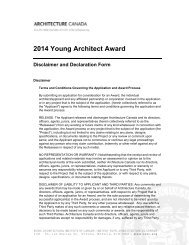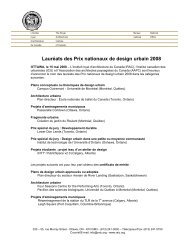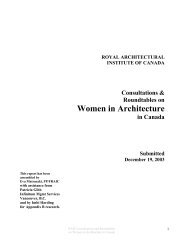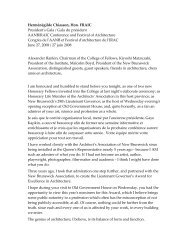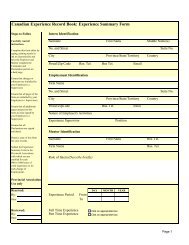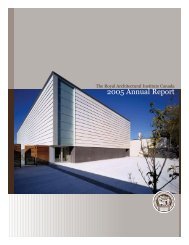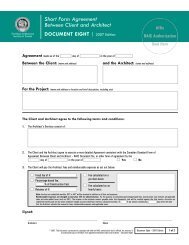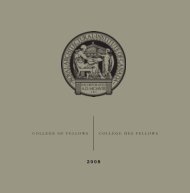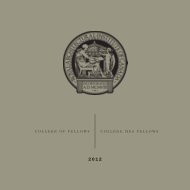Benchmark Study on Green Buildings - Royal Architectural Institute ...
Benchmark Study on Green Buildings - Royal Architectural Institute ...
Benchmark Study on Green Buildings - Royal Architectural Institute ...
Create successful ePaper yourself
Turn your PDF publications into a flip-book with our unique Google optimized e-Paper software.
natural open space caused by development. Because of high urban density to real estate<br />
values, Germany provides indirect and direct subsidies and ordinances for the installati<strong>on</strong><br />
of green roofs. In 1996 a survey d<strong>on</strong>e by Zentralverband Gartenbau e.V. (ZVG), The<br />
Gardening Central Associati<strong>on</strong>, revealed that approximately 50%, or over 80 cities in<br />
Germany offer incentives to building owners utilizing green roofs, or have regulati<strong>on</strong>s in<br />
place that support green roof implementati<strong>on</strong>. It is also estimated that about 1 in every 10<br />
flat roofs in these cities is green. The green roofing industry has also become a highly<br />
competitive market. For instance, in Nurnberg, a city of about 200,000 people, more than<br />
40 companies install green roofs and related green infrastructure projects.<br />
Taxes are also collected <strong>on</strong> anticipated storm water c<strong>on</strong>trol or usage fees, and are used to<br />
cover c<strong>on</strong>structing, maintaining and replacing storm water management facilities. A<br />
100% utility surcharge is levied against owners of impervious roof covers, and thirteen<br />
German cities allow a reducti<strong>on</strong> between 50% and 80% of the utility fee for using a green<br />
roof. In the 1996 ZVG study, it was also found that over a 36-year period, the reducti<strong>on</strong><br />
in the usage fee al<strong>on</strong>e can compensate the building owner for as much as 50% of the<br />
green roof’s capital cost. Another type of indirect subsidy lets developers use green roofs<br />
as mitigati<strong>on</strong> for the provisi<strong>on</strong> of open space. Depending <strong>on</strong> the type of proposed plant<br />
material, local land development ordinances allow green roofs to compensate for lost<br />
open space at a ratio of .50 to .70. This creates a very attractive alternative in areas of<br />
high real estate prices. Alternatives for mitigati<strong>on</strong> include the restorati<strong>on</strong> of existing<br />
impervious surfaces to create open space or improving the biodiversity of existing open<br />
space.<br />
Twenty-nine German cities provide a direct m<strong>on</strong>etary subsidy to developers who use<br />
green roofs. The amount of the subsidy varies widely, ranging between $0.51 to $6.20 per<br />
square foot ($5.5 to $67/m²). Most cities have adopted a financial aid ceiling for<br />
individual projects, ranging from $280 to $11,250 per municipality. The subsidies are<br />
based <strong>on</strong> estimates of the avoided costs associated with infrastructure maintenance and<br />
replacement. The subsidy structure provides the greatest incentive to residences and small<br />
building owners, as they have more roof area per volume of interior space.<br />
It is anticipated that the German Government will so<strong>on</strong> call for all new flat roofs to be<br />
fitted with green roof systems, as it becomes more and more possible to do so. In 1989,<br />
27 German cities had already established z<strong>on</strong>ing districts that required green roofs to be<br />
installed <strong>on</strong> flat roofs, so this predicti<strong>on</strong> is not completely out of the questi<strong>on</strong>. Since 1984<br />
Munich has included green roofs in its building ordinance, and in the subsequent 15 years<br />
approximately 4.2 milli<strong>on</strong> square feet of rooftops have been greened. In 1992 a direct<br />
subsidy program was started, providing $3.13 per square foot ($33.70/m²), paying up to<br />
50% of the capital cost of installing a green roof. In 1996, it is estimated that over 10<br />
milli<strong>on</strong> square meters of green roofing was c<strong>on</strong>structed in Germany al<strong>on</strong>e. The 1996<br />
ZVG green roofing study has estimated that the lifetime cost of an extensive green roof<br />
(based <strong>on</strong> a 36 year service life) in Germany is 15% lower than a comparable bituminous<br />
roof with gravel ballast. This estimate includes savings achieved through the eliminati<strong>on</strong><br />
of storm water detenti<strong>on</strong> basins, and takes into account the higher c<strong>on</strong>structi<strong>on</strong> costs.<br />
75



